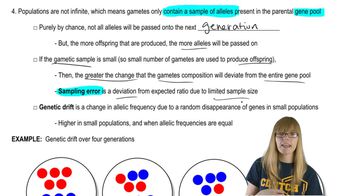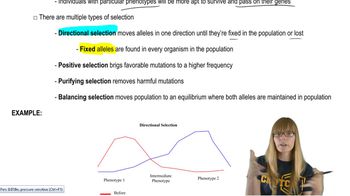Here are the essential concepts you must grasp in order to answer the question correctly.
Allelic Polymorphism
Allelic polymorphism refers to the occurrence of two or more different alleles at a specific gene locus within a population. This genetic variation is crucial for evolution, as it provides the raw material for natural selection and adaptation. Polymorphism can arise from mutations, gene flow, or other genetic mechanisms, leading to diverse phenotypes that can enhance a population's resilience to environmental changes.
Recommended video:
New Alleles and Migration
Genetic Drift
Genetic drift is a stochastic process that leads to random changes in allele frequencies within a population, particularly in small populations. It can result in the loss of genetic variation and the fixation of alleles, contributing to allelic polymorphism by creating distinct genetic profiles among isolated groups. This mechanism can lead to the emergence of new alleles over time, influencing evolutionary trajectories.
Recommended video:
Balancing Selection
Balancing selection is a form of natural selection that maintains multiple alleles in a population by favoring heterozygous individuals. This can occur through mechanisms such as heterozygote advantage, where individuals with two different alleles have a higher fitness than those with two identical alleles. This process promotes genetic diversity and can lead to stable polymorphisms, allowing populations to adapt to fluctuating environments.
Recommended video:
 Verified step by step guidance
Verified step by step guidance Verified video answer for a similar problem:
Verified video answer for a similar problem:

